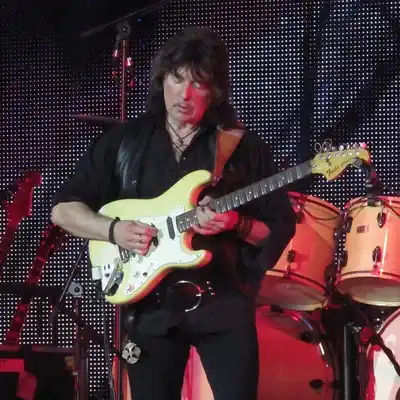
Ritchie Blackmore – The Legendary Guitarist and His Guitars
Ritchie Blackmore is an enigmatic and legendary figure in the world of rock and roll. He has been an influential guitarist for over five decades. Having contributed to the formation of two pioneering rock bands – Deep Purple and Rainbow – he has left an indelible mark on the history of rock music.
In this post, we explore the life of Ritchie Blackmore, his iconic guitars, and the equipment that has defined his sound.
Table of Contents
Early Life and Career
Richard Hugh Blackmore was born on April 14, 1945, in Weston-super-Mare, England. His passion for music was evident from an early age.
He began playing the guitar at the age of 11 and was heavily influenced by the works of Django Reinhardt, Jimi Hendrix, and Hank Marvin. His professional career kicked off in the early 1960s when he joined various British pop and rock bands, including The Outlaws, Screaming Lord Sutch, and Neil Christian & The Crusaders.
Deep Purple
In 1968, Blackmore co-founded Deep Purple, alongside Jon Lord, Ian Paice, Rod Evans, and Nick Simper. Deep Purple quickly gained recognition as one of the first hard rock bands, with their groundbreaking album “Deep Purple in Rock” (1970). During his tenure with the band, Blackmore contributed to several classic albums, such as “Machine Head” (1972) and “Burn” (1974).
His innovative guitar playing, which combined blues, classical, and rock elements, helped establish Deep Purple as a pioneer in heavy metal.
Rainbow
In 1975, Blackmore left Deep Purple to form Rainbow with the late Ronnie James Dio, the legendary vocalist best known for his work with Black Sabbath.
Rainbow’s debut album, “Ritchie Blackmore’s Rainbow” (1975), showcased Blackmore’s evolving musical style and further solidified his reputation as a guitar virtuoso.
Over the years, Rainbow went through numerous lineup changes, with Blackmore remaining as the sole constant member. The band released iconic albums like “Rising” (1976) and “Long Live Rock ‘n’ Roll” (1978) before disbanding in 1984.
Blackmore’s Night
In 1997, Blackmore formed Blackmore’s Night, a Renaissance-inspired folk-rock band, with his partner Candice Night. This project showcased a softer, more melodic side to his playing, focusing on acoustic and classical guitar styles. Blackmore’s Night has released several successful albums, including “Shadow of the Moon” (1997) and “Nature’s Light” (2021), and continues to perform and record to this day.
Guitars and Equipment
Ritchie Blackmore’s iconic sound can be attributed to his choice of guitars and equipment. Here are some of the most crucial elements of his setup:
- Fender Stratocaster: Blackmore’s primary guitar throughout his career has been the Fender Stratocaster. His iconic black Strat, often fitted with a white scalloped maple fingerboard, has become synonymous with his playing style. The scalloped fingerboard allows for greater string bending and vibrato control, contributing to his signature sound.
- Custom Guitar Picks: Blackmore is known for using custom-made guitar picks, which are slightly larger and thicker than standard picks. This unique choice provides him with better grip and control, allowing for precise and expressive playing.
- Amplifiers: Blackmore’s amplifiers have varied throughout his career, but he is best known for using Marshall amplifiers during his time with Deep Purple and Rainbow. He used Marshall Major 200-watt “Piggyback” heads, often paired with Marshall 4×12 cabinets loaded with Celestion speakers. This powerful setup contributed to his massive, overdriven sound. In his later years, Blackmore switched to using Engl amplifiers, which provided a versatile tonal palette suitable for his diverse musical explorations with Blackmore’s Night.
- Effects: Ritchie Blackmore’s effect chain has remained relatively simple over the years. His primary effects include a tape echo unit, such as the Maestro Echoplex or Roland RE-201 Space Echo, and a treble booster like the Hornby Skewes Treble Booster or the BSM RM Treble Booster. These effects helped to shape his distinctive, overdriven lead tone.
- Signature Guitar: In 1997, Fender released the Ritchie Blackmore Signature Stratocaster, which featured many of his custom modifications, including a scalloped fingerboard, Seymour Duncan Quarter Pound pickups, and a modified electronics setup. This guitar remains a popular choice among fans and guitarists alike, capturing the essence of Blackmore’s unique playing style.
Ritchie Blackmore’s innovative guitar playing, groundbreaking work with Deep Purple and Rainbow, and continued exploration of different musical genres with Blackmore’s Night have solidified his status as a true guitar legend.
